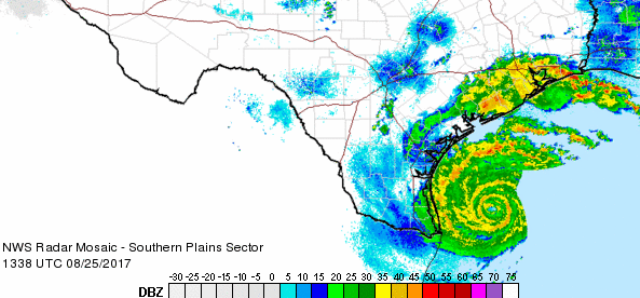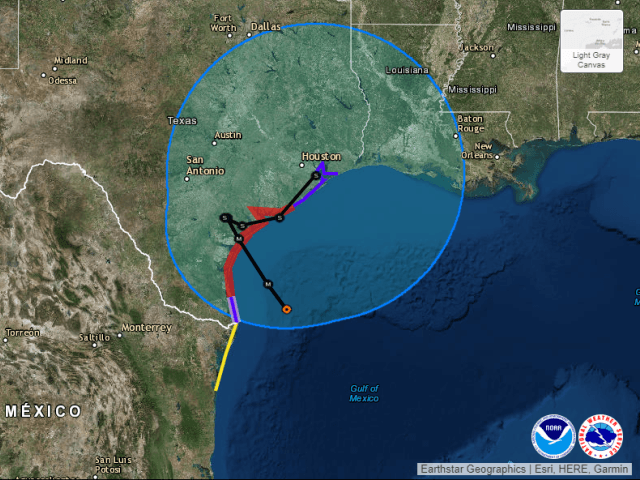HOUSTON, Texas — Hurricane Harvey intensified overnight to become a Category 2 storm. It is expected to become a major storm later on Friday and will likely be Category 3 or 4 by the time the eye crosses over the coastal town of Rockport Friday night.
“Communities along the Gulf Coast, specifically the Corpus Christi and the Houston areas, are at greatest risk of being impacted by this severe weather,” Texas Governor Greg Abbott wrote in a statement Friday morning.

Friday morning Radar image of Hurricane Harvey via NOAA.gov.
“My priority, as we prepare for Hurricane Harvey, is the safety of those on and near the Gulf Coast,” the Texas governor stated. “That is why I am strongly urging all Texans in Harvey’s path to heed warnings and evacuation orders from local officials before this storm makes landfall. My office is coordinating local, state and federal resources to prepare for and respond decisively to this storm—Texans must also take action and treat this storm seriously.”
On Friday morning, Hurricane Harvey reached the maximum sustained winds for a Category 2 storm (110 mph). The center of the storm is expected to cross San Jose Island and the coastal communities of Rockport and Fulton late Friday evening or early Saturday morning.
The potentially deadly storm will bring a storm surge of 6 to 12 feet that will range from North Padre Island to Sargent. Damaging hurricane force winds are expected along throughout that same stretch. A storm surge of five to eight feet is expected on the upper Texas coast from Sargent to Jamaica Beach near Galveston. Large and destructive waves will cause major damage all along the Texas coast, the National Hurricane Center reported Friday morning.
After the winds begin to decrease, the real danger of Harvey will become apparent as the storm is predicted to stall about 50 miles inland and dump catastrophic rainfall of up to 30 inches over a five to seven-day period.
The storm is expected to resume its movement and return to the coastline near Port Lavaca, re-entering the Gulf of Mexico briefly before setting its sights on the Houston metropolitan area on Wednesday.
Governor Abbott urged his fellow Texans to heed the warnings issued by local emergency management authorities. He said coastal and other residents of areas that will likely flood from the massive rainfall totals should follow the voluntary evacuation orders.
Abbott connected with President Donald Trump through a phone call Thursday afternoon and with officials of the Department of Homeland Security (DHS) and the Federal Emergency Management Agency (FEMA) earlier on Thursday to discuss the federal government’s plans for responding to the storm that is likely to bring catastrophic damage to major areas of Texas.
The governor’s office asked Texans to review the State’s published safety information that includes the following instructions:
- Board up doors and windows with plywood or install storm shutters. Keep in mind that winds are stronger at higher elevations, such as high-rise apartments or condos.
- Bring in outdoor objects that could become deadly missiles, such as patio furniture, hanging plants, trash cans, gardening tools and barbecues.
- If your home is vulnerable to rising water, move furniture and valuables to a higher level.
- Before evacuating, cut off your electricity and turn off the gas. Downed electrical wires and broken gas pipes can be deadly and cause serious property damage. Make a final walk-through inspection of your home before leaving.
- Moor boats securely or move them to designated safe areas well in advance of hurricanes. Do not try to tow a trailer or boat in high winds.
- Assemble a family emergency supplies kit and have it ready to go at a moment’s notice.
- When officials recommend or order an evacuation, leave. Do not try to ride out a hurricane in a high-risk area. Seek shelter inland with family or friends, at a hotel or designated shelter. Notify relatives and friends of your plans, and confirm hotel reservations.
- Find out where shelters are located along your route in case clogged roads prevent you from reaching your destination.
- Look at the evacuation maps for your area ahead of time.
Bob Price serves as associate editor and senior political news contributor for Breitbart Texas. He is a founding member of the Breitbart Texas team. Follow him on Twitter @BobPriceBBTX and Facebook.

COMMENTS
Please let us know if you're having issues with commenting.